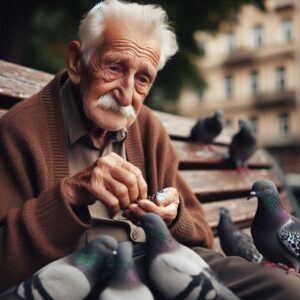Mental health concerns are prominently linked to loneliness. Depression is a significant consequence, with lonely individuals often experiencing persistent sadness and hopelessness. These feelings can severely diminish their quality of life and hinder everyday activities. Anxiety is another prevalent issue, where the stress of feeling isolated leads to heightened worry and fear. This can deter older adults from engaging in social interactions, further deepening their sense of isolation. Loneliness can accelerate cognitive decline. Social engagement is necessary for maintaining cognitive functions such as memory, attention, and problem-solving abilities. The lack of interaction and stimulation can hasten the deterioration of these faculties.
Physically, loneliness inflicts severe consequences on health. It is associated with an increased risk of cardiovascular diseases, such as elevated blood pressure, heart disease, and stroke. Chronic loneliness can trigger a stress response that negatively impacts heart health. The immune system suffers. Socially isolated individuals often have weaker immune responses, making them more prone to infections and illnesses, with slower recovery times. Research has shown that the cumulative effect of loneliness can increase the risk of early mortality. The combined impact of compromised mental and physical health due to loneliness can significantly shorten life expectancy.
Causes of Loneliness in Seniors
Retirement can result in the loss of daily interactions with colleagues and a sense of purpose, fostering feelings of isolation. Similar feelings can arise after the loss of a spouse, friend, or family member. Bereavement creates emotional voids that are challenging to fill, leaving seniors feeling alone and disconnected.
Chronic illnesses and declining physical health can limit mobility, making it difficult for seniors to engage in social activities or even leave their homes. This leads to feelings of frustration and helplessness, amplifying the sense of loneliness.
 A significant number of seniors live alone, which can heighten feelings of solitude. The physical environment can become restrictive, especially if the person resides in a poorly accessible area or housing unsuitable for their mobility needs. Geographic relocation, undertaken to be closer to family or for transitioning into assisted living facilities, can disconnect seniors from their established social networks. This can make rebuilding a new social circle daunting and stressful.
A significant number of seniors live alone, which can heighten feelings of solitude. The physical environment can become restrictive, especially if the person resides in a poorly accessible area or housing unsuitable for their mobility needs. Geographic relocation, undertaken to be closer to family or for transitioning into assisted living facilities, can disconnect seniors from their established social networks. This can make rebuilding a new social circle daunting and stressful.
Many seniors find it challenging to adapt to new forms of communication, such as social media, video calls, or even texting. This technological divide can result in exclusion from family updates and social conversations occurring online, furthering the feeling of isolation.
Financial strain can restrict access to social activities, community events, or even basic transportation, making it difficult for seniors to participate in social engagements. Economic hardships can increase stress and anxiety, compounding the mental health issues associated with loneliness.
Societal attitudes towards aging can influence how seniors perceive themselves and their worth. Negative stereotypes and ageism can lead to feelings of invisibility and undervaluation, fostering social withdrawal and loneliness. Seniors from diverse cultural backgrounds might face difficulties in maintaining connections if language barriers or cultural misunderstandings exist within their communities.
Combating Loneliness in Older Adults
Regular family visits are important in maintaining a sense of community and belonging. Family members can create a visitation schedule to ensure frequent interactions with their elderly loved ones. Communities should offer various social programs designed for seniors. These might include activities hosted at community centers, senior clubs, or religious organizations, where older adults can engage in organized events and build new relationships.
Video calls through platforms such as Skype, Zoom, or FaceTime allow older adults to stay connected with family and friends. Local libraries or community centers could offer training sessions to help seniors become comfortable using these technologies.
libraries or community centers could offer training sessions to help seniors become comfortable using these technologies.
Exercise classes specifically designed for seniors, such as yoga, tai chi, or water aerobics, offer opportunities for older adults to stay active while meeting new people. Walking groups provide an excellent way for seniors to get outside and engage in regular physical activity while socializing with peers.
Counseling services tailored for older adults can offer professional help to those struggling with feelings of isolation or depression. These sessions can provide a safe space to talk about their feelings and develop coping strategies. Support groups are equally beneficial, allowing seniors to share their experiences and gain support from others facing similar challenges. Many communities offer specialized groups for bereavement, illness management, and other common issues among older adults.
Teaching seniors how to use social media platforms, like Facebook or Instagram, can keep them in the loop with family developments and community events. Online communities, such as virtual book clubs or discussion forums, can provide a platform for interaction and engagement. Public libraries or local tech initiatives often offer instructional classes to aid seniors in learning these skills.
For seniors capable of caring for animals, adopting a pet might provide much-needed companionship and a sense of purpose. Pet therapy programs, where trained animals visit nursing homes or assisted living facilities, can offer emotional uplift and foster connections between residents and therapy animals.
Maintaining a balanced diet and regular health check-ups can enhance overall well-being, making it easier to combat loneliness. Good nutrition positively impacts mood and energy levels, while regular health professional visits can address any underlying health issues contributing to feelings of isolation.
The Role of Caregivers and Families
Involving older adults in family activities fosters a sense of belonging and purpose. These activities offer opportunities for social interaction in a familiar and supportive environment, which is necessary for their emotional well-being.
Limited mobility is a common issue among older adults and can significantly contribute to feelings of isolation. Providing transportation assistance can open up a world of opportunities for social engagement. Family members and caregivers can help by offering rides to social events, medical appointments, religious services, or community activities. This encourages them to remain active and engaged.
 Making necessary home modifications, such as installing grab bars, ramps, or stairlifts, can enhance mobility and independence within the home. A well-structured and accessible living space allows seniors to navigate their homes confidently, reducing the risk of accidents and promoting a more active lifestyle.
Making necessary home modifications, such as installing grab bars, ramps, or stairlifts, can enhance mobility and independence within the home. A well-structured and accessible living space allows seniors to navigate their homes confidently, reducing the risk of accidents and promoting a more active lifestyle.
Introducing seniors to community centers, clubs, or special interest groups that align with their hobbies can help them form new connections. Caregivers can encourage participation in volunteer opportunities or educational classes designed for older adults, both of which provide avenues for social interaction and personal fulfillment.
Caregivers can assist by ensuring seniors keep up with medical appointments, manage their medications, and maintain a balanced diet. Prompt attention to health issues can prevent them from escalating and becoming barriers to social engagement.
Families and caregivers can connect with local community services, senior centers, and non-profit organizations that offer resources and programs for older adults. Establishing a network ensures a comprehensive support system where seniors can access a variety of services and activities, further combating loneliness.
Advocating for better access to healthcare, transportation, social programs, and affordable housing can create a more senior-friendly environment. Participation in local initiatives and public forums can also highlight the importance of addressing senior loneliness and driving community efforts to support older adults.